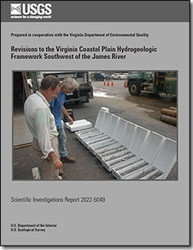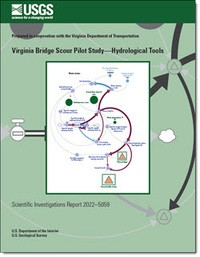
Product Details
- Product Number
- 534192
- Series
- SIR-2022-5049
- Scale
- NO SCALE
- Alternate ID
- SIR2022-5049
- ISBN
- 978-1-4113-4487-7
- Authors
- E RANDOLPH MCFARLAND
- Version Date
- 01/01/2022
- Regions
- VA
- Countries
- USA
- Media
- Paper
- Format
- Bound
Additional Details
- Description
-
Revisions to the Virginia Coastal Plain Hydrogeologic Framework Southwest of the James River
First posted June 23, 2022
For additional information, contact:
Director, Virginia and West Virginia Water Science Center
https://www.usgs.gov/centers/virginia-and-west-virginia-water-science-ce nter
U.S. Geological Survey
1730 East Parham Road
Richmond, VA 23228
Abstract
hydrogeologic units of the Virginia Coastal Plain aquifer system differ by as much as 50 feet (ft) from those previously known, namely the Aquia and Potomac aquifers, the Potomac confining zone, and the Nanjemoy-Marlboro and Saint Marys confining units. In addition, the lateral margins of some hydrogeologic units are located as much as several miles from previously estimated locations. The largest revisions to unit margins were for the Aquia aquifer and the Nanjemoy-Marlboro and Saint Marys confining units. Interpretation of new geophysical logs, sediment core, and cuttings as well as revised interpretations to existing data indicate channels and embayments are also preserved on eroded top surfaces of the shallowest hydrogeologic units including the Yorktown confining zone, Yorktown-Eastover aquifer, Saint Marys confining unit, Potomac confining zone, and Potomac aquifer.
Enhanced details on the configuration of part of the aquifer system southwest of the James River are provided by sediment cores and cuttings as well as geophysical logs from 36 recently drilled boreholes. These, along with reinterpretation of data from 93 preexisting boreholes, form the basis for revised top-surface altitudes and margins of hydrogeologic units beneath parts of Prince George, Surry, Sussex, Isle of Wight, and Southampton Counties and the cities of Franklin and Suffolk.
Groundwater withdrawals in the Virginia Coastal Plain cause widespread water-level declines, create the potential for saltwater intrusion, and contribute to regionwide land subsidence. A description of the aquifer system, termed a hydrogeologic framework, was developed by the U.S. Geological Survey in 2006 and provides information needed to base withdrawal-permitting decisions by the Virginia Department of Environmental Quality. This revision of part of the hydrogeologic framework southwest of the James River is based on interpretations of both new and previously analyzed borehole data. The revision is strictly confined to the study area extent and hydrogeologic units not found within the study area were not revised and are not discussed in this report. The newly determined hydrogeologic-unit altitudes and margins have implications for groundwater-withdrawal permitting. New interpretations have found that the Yorktown Eastover aquifer is absent in the southwestern part of the City of Suffolk, owing to what is most likely an isolated area of sediment-texture facies change. Most notably, the top-surface altitudes of the Aquia and Potomac aquifers have been lowered by as much as 50 ft from previous interpretations. This means that wells previously believed to be screened in the top of the Potomac aquifer could, based on these new interpretations, be screened in the bottom of the Aquia aquifer. These changes to aquifers in which wells are screened means that there is potentially more room in the groundwater withdrawal permitting for the Potomac aquifer, the largest and most productive aquifer in Virginia, and overpumping occurring in the Aquia aquifer.
- Survey Date
- 2022
- Print Date
- 2022
- Height In Inches
- 11.000
- Length In Inches
- 8.500
- Two Sided
- Yes
- Pieces
- 1
- Languages
- English





